#colorful moths
Explore tagged Tumblr posts
Text
The Oriental Blue Clearwing Moth: these moths were regarded as a "lost species" for more than 130 years, until they were finally sighted again in 2013
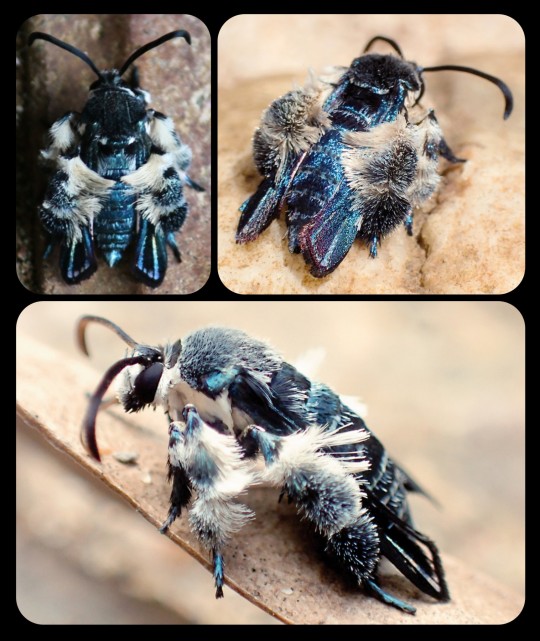
For more than 130 years, the Oriental blue clearwing moth (Heterosphecia tawonoides) was known only from a single, badly damaged specimen that was collected in Sumatra in 1887. There were no recorded sightings of this species again until 2013, when entomologist Dr. Marta Skowron Volponi unexpectedly found the moths feeding on salt deposits that had accumulated along the riverbanks in Malaysia's lowland rainforest.
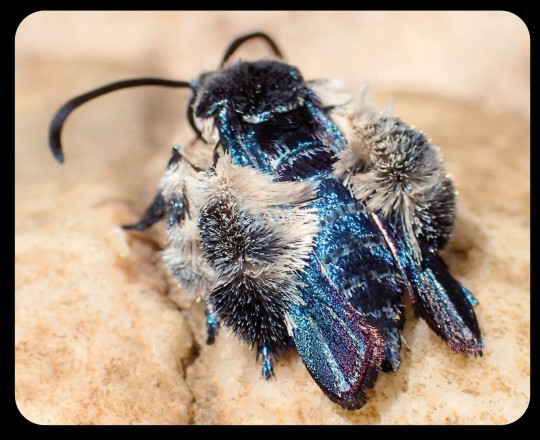
These moths were observed by researchers again in 2016 and 2017, and research indicates that the moths are actually bee-mimics, as they mimic the appearance, sound, behavior, and flight patterns of local bees. Their fuzzy, bright blue appearance might seem a little out of place for a bee-mimic, but those features do appear in several different bee species throughout Southeast Asia.
When the moths are in flight, they bear a particularly strong resemblance to the bees of the genus Thyreus (i.e. cuckoo bees, otherwise known as cloak-and-dagger bees), several of which are also bright blue, with banded markings, dark blue wings, fuzzy legs, and smooth, rounded antennae. The physical resemblance is compounded by the acoustic and behavioral mimicry that occurs when the moths are in flight.
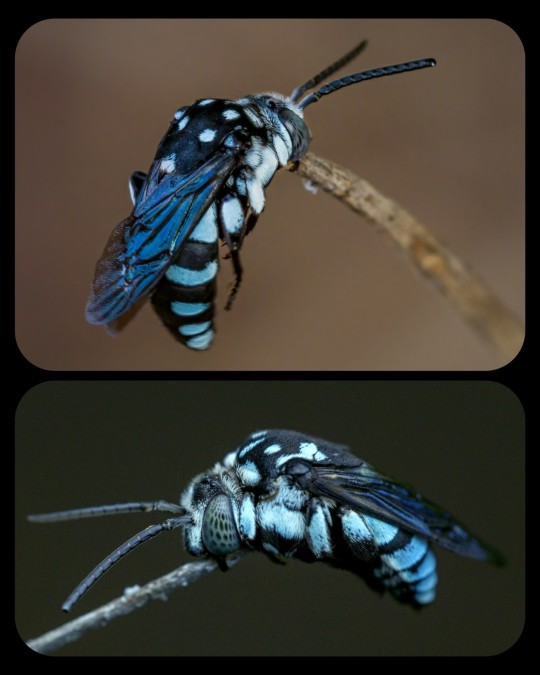
Cloak-and-Dagger Bees: the image at the top shows an Indo-Malayan cloak-and-dagger bee (Thyreus novaehollandiae) in a sleeping position, holding itself upright with its mandibles clamped onto a twig, while the image at the bottom shows a Himalayan cloak-and-dagger bee (T. himalayensis) resting in the same position
The moths also engage in "mud-puddling" among the various bees that congregate along the riverbanks; mud-puddling is the process whereby an insect (usually a bee or a butterfly) draws nutrients from the fluids found in puddles, wet sand, decaying plant matter, carrion, animal waste, sweat, tears, and/or blood. According to researchers, the Oriental blue clearwing moth was the only lepidopteran that was seen mud-puddling among the local bees.
Dr. Skowron Volponi commented on the unusual appearance and behavior of these moths:
You think about moths and you envision a grey, hairy insect that is attracted to light. But this species is dramatically different—it is beautiful, shiny blue in sunlight and it comes out during the day; and it is a master of disguise, mimicking bees on multiple levels and even hanging out with them. The Oriental blue clearwing is just two centimeters in size, but there are so many fascinating things about them and so much more we hope to learn.
This species is still incredibly vulnerable, as it faces threats like deforestation, pollution, and climate change. The president of Global Wildlife Conservation, which is an organization that seeks to rediscover "lost species," added:
After learning about this incredible rediscovery, we hope that tourists visiting Taman Negara National Park and picnicking on the riverbanks—the home of these beautiful clearwing moths—will remember to tread lightly and to take their trash out of the park with them. We also recommend that Americans learn about palm oil production, which is one of the primary causes of deforestation in Malaysia.
Sources & More Info:
Phys.org: Bee-Mimicking Clearwing Moth Buzzes Back to Life After 130 Years
Mongabay News: Moth Rediscovered in Malaysia Mimics Appearance and Behavior of Bees to Escape Predators
Journal of Tropical Conservation Science: Lost Species of Bee-Mimicking Clearwing Moth, H. tawonoides, Rediscovered in Peninsular Malaysia's Primary Rainforest
Frontiers in Zoology: Southeast Asian Clearwing Moths Buzz like their Model Bees
Royal Society Publishing: Moving like a Model - mimicry of hymenopteran flight trajectories by clearwing moths of Southeast Asian rainforests
Medium: Rediscovery in a Glint of Blue
re:wild.org: The "Search for Lost Species" Project
#lepidoptera#moths#heterosphecia tawonoides#oriental blue clearwing moth#entomology#insects#cute bugs#nature#animals#lost species#mimicry#evolution#bees#southeast asia#Malaysia#colorful moths#bee mimic#science
1K notes
·
View notes
Text

Scarce Merveille du Jour moth (Moma alpium) camouflaged against lichen -
Photo by Robert Thompson
#moma alpium#Scarce Merveille du Jour moth#Scarce Merveille du Jour#moths#colorful moths#camouflage#insects#lepidoptera#lichen#nature#animals
22 notes
·
View notes
Note
Hey! I'm planning on getting a moth tattoo piece sometime soon. What are some of the most colorful moths you've seen doing this page? Or any moths you think would work well with it
Here are some of the most colorful moths I've covered in the blog!
Giant Leopard Moth
Chinese Moon Moth
Lily Moth
Elephant Hawk-moth
Western Sheep Moth
Io Moth
Hope this is helpful! Feel free to send the result once you get it, I'd love to see it!
71 notes
·
View notes
Text
The Ilia Underwing is a Beautiful Summer Moth
Ilia Underwing This little beauty was taking her afternoon siesta on the wall of my dog house one afternoon. I was busy doing chores when I first noticed her, so taking some time out to get her photo was a welcome distraction. She is an ilia underwing moth (Catocala ilia), which is one of the more colorful moths we get around here. They’re nocturnal, so many people never get to see them. During…

View On WordPress
#colorful Florida moths#colorful insects#colorful moths#Florida insects#Florida moths#ilia underwing#ilia underwing moth#insect photographs#insect photography#insects#moth photographs#moth photography#moths#nocturnal insects#summer insects#summer moths
1 note
·
View note
Text


Though colloquially called the Bark-winged Birdsnatcher, the most common prey items of this little dragon are the fingers of unsuspecting entomologists.
#smaugust#smaugust 2024#dragons#moths#creature design#fantasy animals#watercolor#colored pencils#entomology
3K notes
·
View notes
Note
can i get a moth gem :3

٩>ᴗ<)و
#fanon swap#geminitay#geminitay fanart#hermitcraft#mcyt#she was originally gonna be a cecropia moth (they are my Favorite)#but ahhhh the colors didnt go as well as i wanted.. so luna moth it is :-D#btw this is an open invitation please send in more fanon swaps!!!! they are so fun!!#my art
1K notes
·
View notes
Text
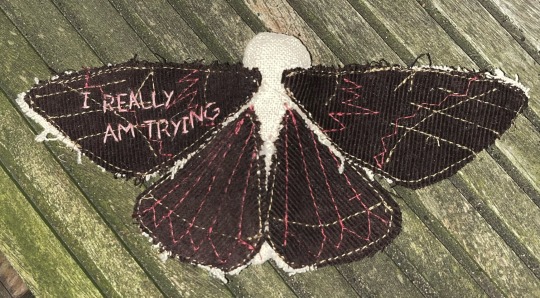
can’t fight your own nature! but you sure can try!!
#this one has my favorite colors i’ve done so far hehe#chiara’s art tag#art#soft sculpture#fiber arts#textiles#sewing#moths#insects#bugs#textile art#fiber crafts
4K notes
·
View notes
Text


i will continue to seek home from within myself @tzulipss ¹旋律 ’ ♡.









#𝑀𝜎𝜏𝘩 𝛳𝑟𝑐𝘩𝜄d𝑠 : the event#ㅤㅤㅤㅤㅤㅤㅤㅤㅤㅤㅤㅤㅤㅤㅤㅤㅤㅤㅤㅤㅤㅤㅤㅤㅤㅤㅤㅤㅤㅤㅤㅤㅤㅤㅤㅤㅤㅤㅤㅤㅤㅤㅤㅤㅤㅤㅤㅤㅤㅤㅤㅤㅤㅤㅤㅤㅤㅤㅤㅤㅤㅤㅤㅤㅤㅤㅤㅤㅤㅤㅤㅤㅤㅤㅤㅤㅤㅤㅤㅤㅤㅤㅤ#kpop moodboard#bts#kpop#bts moodboard#clean moodboard#alt moodboard#pretty moodboard#cute moodboard#weird moodboard#ugly moodboard#indie moodboard#edgy moodboard#grunge moodboard#visual archive#archive moodboard#pink moodboard#green moodboard#white moodboard#mood board#moodboard#colorful moodboard#y2k moodboard#vintage moodboard#moth orchid#kpop layouts#messy symbols#dividers#messy moodboard
837 notes
·
View notes
Text

The Demon provokes me: after you, be my guest! [Demons Banquet]
Hickory horned devil -> Regal moth Damian
#anyway the regal moth is known as a midsummer moth and the caterpillars are spectacular: brightly colored and ominous BUT not poisonous#damian hasn't reached his 4th instar [molt] yet but he will#as i've tagged before robin is like the larval stage of gotham vigilantes in this essay i will-#yes this is another addition to my series of bugs including mantis nightwing and cicada jason#damian wayne#damian al ghul#dc universe#dcu#dc comics#batman#dc fanart#batfam#my art#dc robin#robin#damian robin
936 notes
·
View notes
Text
The Madagascan Sunset Moth: these moths are often mistaken for butterflies, thanks to their colorful, iridescent appearance

The scientific name of this species is Chrysiridia rhipheus, but it's commonly known as the Madagascan sunset moth. These gorgeous day-flying moths can be found only in Madagascar.
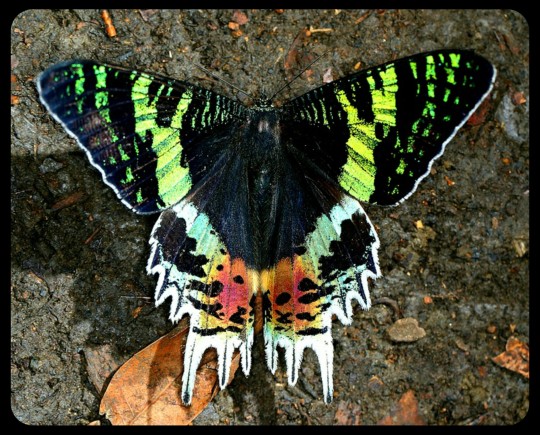
Above: a dorsal view of the same species
The Madagascan sunset moth has a strikingly colorful appearance, especially when its underwings are exposed, as a rainbow-like effect is produced by the iridescent scales that cover the underwings (and appear in smaller sections on the dorsal side of the wing).
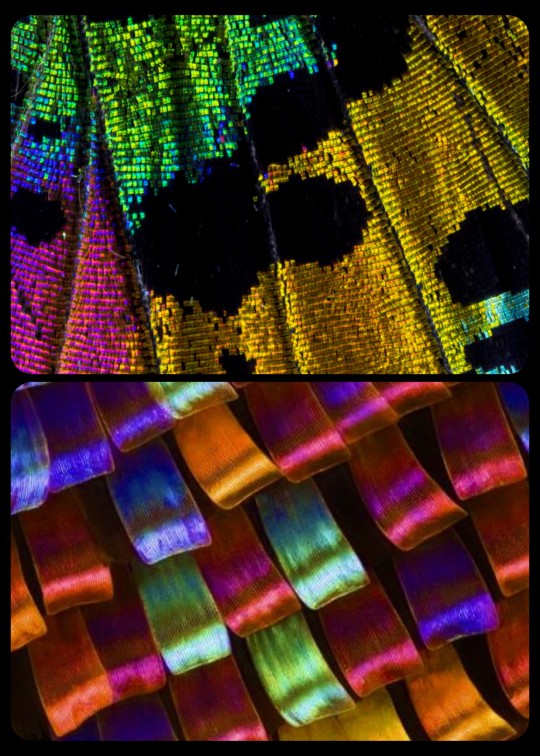
Above: some of the iridescent scales on the underwings of Chrysiridia ripheus, as seen through a scanning electron microscope
The markings on the dorsal side are primarily black, with some patches of iridescent green, blue, and red. A "fringe" of white scales can also be seen along the edge of each wing; these are especially prominent on the hindwings.

Above: the dorsal patterns are visible only when the wings are left open
Like most day-flying moths, the adults of this species will often feed on nectar. Their caterpillars are known to consume Omphalea plants, which are toxic; those toxins are sequestered by the caterpillar and then retained through the pupal and adult stages of development, which means that the adult moth is toxic. Their colorful appearance is likely aposomatic, deterring predators by signaling that the moth itself is toxic.

Above: a magnified view of the white scales that outline the hindwings
Sources & More Info:
Navsari Agricultural University: Sunset Moth: the most beautiful insect
Oxford University Museum of Natural History: Madagascar
Moth Identification Guide: Madagascan Sunset Moth
California Academy of Sciences: Sunset Moth
Optica: Polarization-Sensitive Color Mixing in the Wing of the Madagascan Sunset Moth
Wikipedia: Chrysiridia rhipheus
#entomology#lepidoptera#madagascan sunset moth#chrysiridia rhipheus#arthropods#moths#insects#urania rhipheus#animal facts#sunset moth#bugs#cool animals#colorful moths#madagascar#aposomatic coloration#moths are amazing#and beautiful#don't let anyone tell you otherwise
600 notes
·
View notes
Text

Indian moon moth (Actias selene)
Photo by Robert Thompson
#indian moon moth#indian luna moth#actias#actias selene#moths#green#green moth#colorful moths#insects#colorful insects#insect wings#nature#animals#entomology
17 notes
·
View notes
Text

Commission for Alex, I loved the design!
#artists on tumblr#character design#commission#commissioned piece#full body full colors#moth character#dnd character
1K notes
·
View notes
Text
Moth Of The Day #222
Madagascan Sunset Moth
Chrysiridia rhipheus
From the uraniidae family. They have a wingspan of 7-11 cm. They inhabit a wide variety of habitatsd, from deciduous forests to rain forest regions. They are endemic to Masagascar.
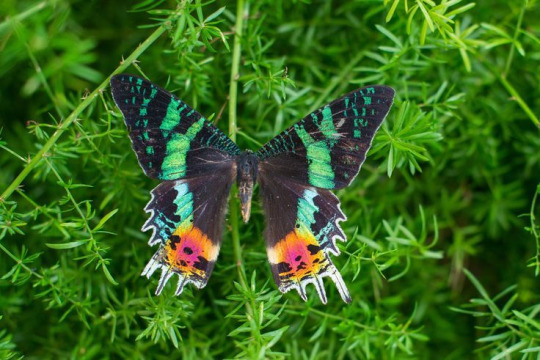
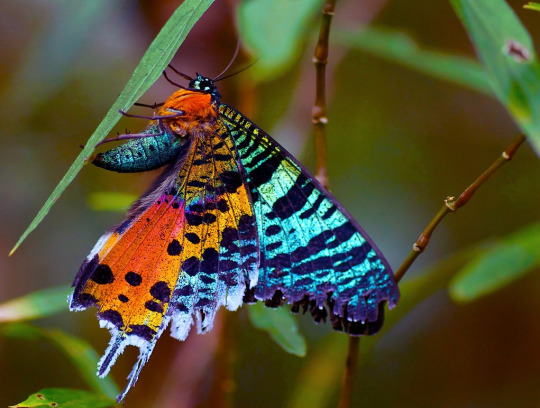
Image sources: [1] [2]
#moth#moths#lepidopterology#lepidoptera#nature#pretty moth#insect#bugs#moth of the day#motd#lepidoptery#bugblr#entomology#beautiful moth#colorful moth#madagascan sunset moth#chrysiridia rhipheus#uraniidae#uraniidae moth#bug#insects
4K notes
·
View notes
Text
The Spragueia Moth is a Most Beautiful Creature
The Spragueia Moth is a Most Beautiful Creature features images of one of the author/artist’s favorite moths. It goes on to explain why she finds these moths so attractive and where this one was found.
A Most Beautiful Moth I have loved these little black dotted Spragueia moths (Spragueia oragrus) since the first time I ever saw one. There is just something about the combination of the orange with the black and white that is really appealing to my eye (even if they do belong to a group of moths collectively known as “bird dropping moths”). They’re tiny little things and many people never see…

View On WordPress
#beautiful insects#beautiful moths#black dotted spragueia moth#colorful insects#colorful moths#Florida insects#Florida moths#Florida spragueia moths#insect photographs#insect photography#insects#moth photographs#moth photography#moths#photography#small moths#spragueia moth
0 notes
Text

mind crab but. again
#mostly just posting to get rid of it tbh ive been holding onto it for like a week now#well i only just now colored it but. still#mostly random scribbles. vaguely wild and secret inspired. because thats what i was watching. i watched them all out of order btw#and also a moth bevause i was trying to see how id see it . id imagine thats what shes like in hermit ? maybe ? and in life shes ouppy#have yet to watch more than 2 hermit episodes per season so far#pearlescentmoon#geminitay#thus concludes the brief minecraft moment. i think.#to be honest i watched all of these while also playing linecraft myself . so i dont. actually remember a whole lot#this is very lazy tbh. in my defense ive been awake for 15 hours now. most of which was spent playing minecarft.#its that time of year where i spent 2 weeks playing minecraft for 10 hours everyday until i explode
481 notes
·
View notes
Text

gave some critters some colors
#pearls hands would be fluffy......... bug paws...............#she is deceptively beelike in her colors. but that is intentional. because hummingbird bee moths are just like that.#weird little hawkmoth thats shaped like a hummingbird and colored like a bee. theyre my favorite bug i love them#i made some small adjustments to gems design from the doodle the other day but nothing major mostly just the collar of her jacket really#hermitcraft#hermitcraft 10#hermitcraft fanart#mcyt#pearlescentmoon#geminitay#shinyduo#w1f1 sketches#theyre both warmer blues but gems blue is *so* warm it makes pearls blue look cool in comparison lol
290 notes
·
View notes